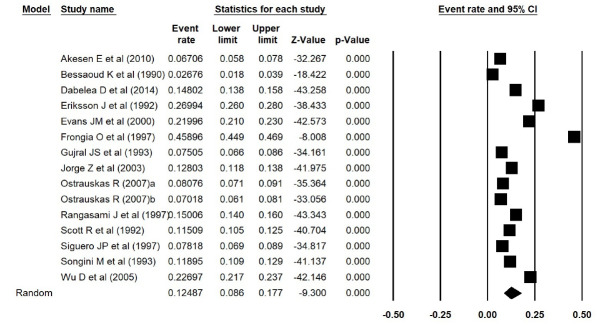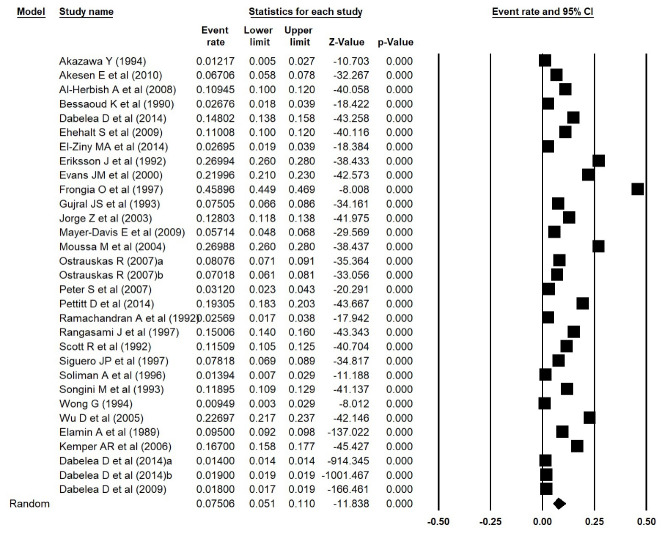Corrigendum
Based on the comments we received from the readers of our article entitled “Prevalence and incidence of type 1 diabetes in the world: a systematic review and meta-analysis”, published in Health Promotion Perspectives, we rechecked the whole of the article and its associated data set, and identified a set of errors and missing attributions that should be corrected as follows:
In the results section, heterogeneity between studies for the prevalence of type 1 diabetes in Asia, Africa, and Europe was incorrectly written as non-significant, while it should have been reported as significant. Also, heterogeneity between the studies in Africa was written as non-significant in the main text, which should have been reported as statistically significant.
In terms of the incidence of type 1 diabetes in America, there is a non-significant heterogeneity, which was incorrectly written as significant in the text. Additionally, in the published paper, there are some incorrect values in Table 3; however, the values used for the meta-analysis are correct. In this table, the correct prevalence values per 100 000 reported from the studies of Mayer-Davis et al,1 Ehehalt et al,2 Erikson et al,3 Evans et al,4 and Lopez Siguero et al5 are 57, 110, 270, 220, and 78, respectively.
Table 3. Characteristics of studies prevalence of type 1 diabetes .
| Study | Country | Sample Size | Prevalence Per 100000 |
| Akazawa193 | Japan | 40 | 10 |
| Akesen et al194 | Turkey | 26 | 67 |
| Al-Herbish et al195 | Saudi Arabia | 42 | 109.5 |
| Aschner et al13 | America | 2827 | 8000 |
| Bessaoud et al18 | Algeria | 10 | 27 |
| Dabelea et al45 | Navajo nation | 40 | 11 |
| 31 | 81 | ||
| 106 | 278 | ||
| Dabelea et al196 | USA | 57 | 148 |
| Ehehalt et al51 | Italy | 3761 | 110 |
| Elamin et al197 | Sudan | 17 | 42.98 |
| El-Ziny et al53 | Egypt | 10 | 26.8 |
| Eriksson et al198 | Finland | 1009 | 270 |
| Evans et al199 | Scotland | 6592 | 220 |
| Frongia et al59 | Italy | 176 | 459 |
| Garancini et al200 | Italy | 31 | 80 |
| Gujral et al201 | UK | 29 | 75 |
| Jorge et al202 | Portugal | 49 | 128 |
| Kemper et al203 | USA | 70 | 183 |
| Mayer-Davis et al100 | USA | 218 | 57 |
| Moussa et al204 | Kuwait | 103 | 269.9 |
| Ostrauskas205 | Lithuania | 31 | 80.64 |
| Ostrauskas and Žalinkevičius206 | Lithuania | 27 | 70.23 |
| Peter et al116 | Bahamas | 12 | 31 |
| Pettitt et al207 | USA | 74 | 193 |
| Ramachandran et al208 | India | 10 | 26 |
| Rangasami et al>127 | Scotland | 58 | 150 |
| Scott et al140 | New Zealand | 44 | 115 |
| López Siguero et al146 | Malaga | 297 | 78 |
| Soliman et al209 | Oman | 50 | 13.25 |
| Songini et al210 | Sardinia | 46 | 119 |
| Wong185 | China | 30 | 8.3 |
| Wu et al211 | New Zealand | 87 | 227 |
Furthermore, Moussa et al6,7 conducted two studies to investigate the prevalence of type 1 and type 2 diabetes among Kuwaiti children, and in our article, instead of the reference of the study on type 1 diabetes,6 the reference of the study considering type 2 diabetes was cited.7 In addition, Peter had two studies, within which the trend of type 1 diabetes,8 and the prevalence and incidence of type 1 diabetes in the Bahamas9 were determined. In our meta-analysis, the first study was mistakenly cited instead of the second study.
In the studies conducted by Dabelea et al,10 Kemper et al,11 Ashner et al,12 and Garancini et al,13the prevalence estimates reported were for overall diabetes, type 1 diabetes, or type 2 diabetes. In our study, however, those estimates were incorrectly extracted as the estimates for overall diabetes or type 2 diabetes. So, the corrections were as follow: for the study of Kemper et al,11 the errors were corrected and the type 1 diabetes data were extracted; the study of Dabelea et al10 was replaced with another publication with more complete information14; for the study of Garancini et al,13 the data on type 1 diabetes were unclear and insufficient to be included in our analysis, and was therefore excluded from the meta-analysis; in the study of Ashner et al,12 the prevalence estimate of type 1 diabetes was not reported, and was thus excluded from our analysis.
In addition, the estimated prevalence of type 1 diabetes reported by Elamin et al15 in Sudan, was extracted incorrectly. We thus corrected the errors and repeated the meta-analyses, and found that the estimated prevalence of type 1 diabetes was 0.038 (95% CI: 0.017 to 0.084, P < 0.001) in Asia (Figure 1 [the corrected form of Figure 2-B in the original article]), 0.052 (95% CI: 0.015 to 0.168, P < 0.001) in Africa (Figure 2 [the corrected form of Figure 5-B in the original article]), 0.125 (95% CI: 0.086 to 0.177, P < 0.001) in Europe (Figure 3 [the corrected form of Figure 3-B in the original article]), 0.050 (95% CI: 0.036 to 0.070, P < 0.001) in America (Figure 4 [the corrected form of Figure 6-B in the original article]), and 0.075 (95% CI: 0.051 to 0.110, P < 0.001) in the world (Figure 5 [the corrected form of Figure 7 in the original article]). Also, the corrected estimated incidence of type 1 diabetes was 0.020 (95% CI: 0.017 to 0.023, P < 0.001) in America (Figure 6 [the corrected form of Figure 6-A in the original article]). Moreover, in the abstract section of our paper, the estimate for the prevalence of type 1 diabetes should be 0.075% (95% CI: 0.051 to 0.110), instead of 9.5% (95% CI: 0.07 to 0.12). In summary, the overall results for the prevalence of type 1 diabetes in the world had a marginal change, and thus the conclusions drawn in our article are not changed.
Figure 1.
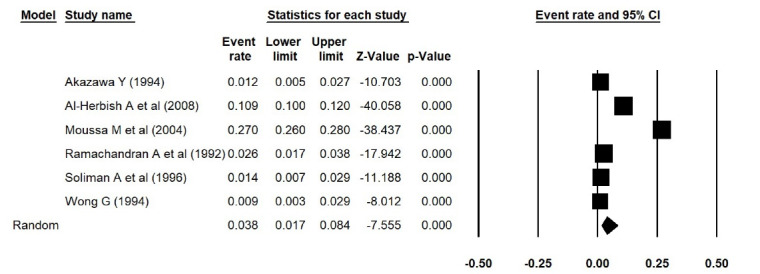
Prevalence of type 1 diabetes in Asia (the corrected form of Figure 2-B in the original article)
Figure 2.

Prevalence of type 1 diabetes in Africa (the corrected form of Figure 3-B in the original article)
Figure 3.
Prevalence of type 1 diabetes in Europe (the corrected form of Figure 5 in the original article)
Figure 4.
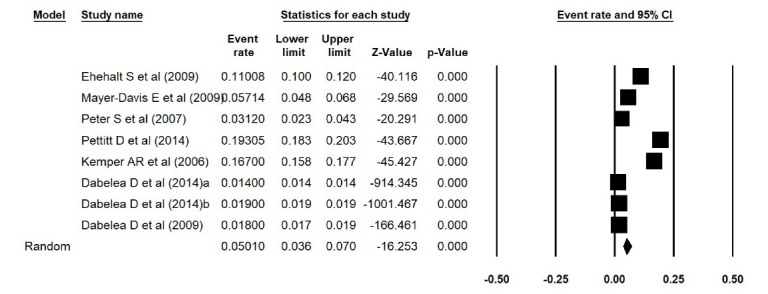
Prevalence of type 1 diabetes in America (the corrected form of Figure 6-B in the original article)
Figure 5.
Prevalence of type 1 diabetes in the world (the corrected form of Figure 7 in the original article)
Figure 6.
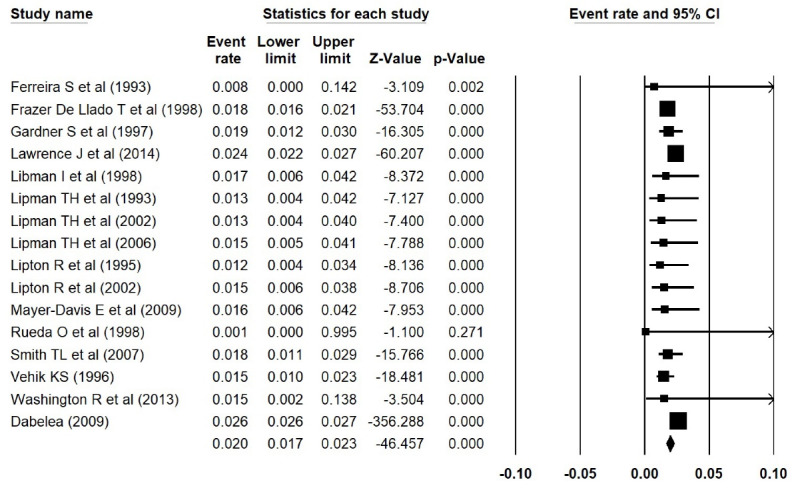
>Incidence of type 1 diabetes in America (the corrected form of Figure 6-A in the original article)
Disclosure
As the team of authors, we take full responsibility for the errors and missing attributions, and appreciate the opportunity to prepare this corrigendum.
References
- 1.Mayer-Davis EJ, Beyer J, Bell RA, Dabelea D, D’Agostino R Jr, Imperatore G, et al. Diabetes in African American youth: prevalence, incidence, and clinical characteristics: the SEARCH for Diabetes in Youth Study. Diabetes Care. 2009;32(Suppl 2):S112–22. doi: 10.2337/dc09-S203. [DOI] [PMC free article] [PubMed] [Google Scholar]
- 2.Ehehalt S, Popovic P, Muntoni S, Muntoni S, Willasch A, Hub R, et al. Incidence of diabetes mellitus among children of Italian migrants substantiates the role of genetic factors in the pathogenesis of type 1 diabetes. Eur J Pediatr. 2009;168(5):613–7. doi: 10.1007/s00431-008-0808-9. [DOI] [PubMed] [Google Scholar]
- 3.Eriksson J, Forsén B, Häggblom M, Teppo AM, Groop L. Clinical and metabolic characteristics of type 1 and type 2 diabetes: an epidemiological study from the Närpes community in western Finland. Diabet Med. 1992;9(7):654–60. doi: 10.1111/j.1464-5491.1992.tb01862.x. [DOI] [PubMed] [Google Scholar]
- 4.Evans JM, Newton RW, Ruta DA, MacDonald TM, Morris AD. Socio-economic status, obesity and prevalence of type 1 and type 2 diabetes mellitus. Diabet Med. 2000;17(6):478–80. [PubMed] [Google Scholar]
- 5. López Siguero JP, Martínez-Aedo Ollero MJ, Moreno Molina JA, Lora Espinosa A, Martínez Valverde A. [The development of the incidence of diabetes mellitus I in children 0 to 14 years of age in Malaga (1982-1993)]. An Esp Pediatr 1997;47(1):17-22. [Spanish]. [PubMed]
- 6.Moussa MA, Alsaeid M, Abdella N, Refai TM, Al-Sheikh N, Gomez JE. Prevalence of type 1 diabetes among 6- to 18-year-old Kuwaiti children. Med Princ Pract. 2005;14(2):87–91. doi: 10.1159/000083917. [DOI] [PubMed] [Google Scholar]
- 7.Moussa MA, Alsaeid M, Abdella N, Refai TM, Al-Sheikh N, Gomez JE. Prevalence of type 2 diabetes mellitus among Kuwaiti children and adolescents. Med Princ Pract. 2008;17(4):270–5. doi: 10.1159/000129604. [DOI] [PubMed] [Google Scholar]
- 8.Peter S. Trends in the incidence of type I diabetes mellitus worldwide. West Indian Med J. 2007;56(3):264–9. doi: 10.1590/s0043-31442007000300015. [DOI] [PubMed] [Google Scholar]
- 9.Peter SA, Johnson R, Taylor C, Hanna A, Roberts P, McNeil P, et al. The incidence and prevalence of type-1 diabetes mellitus. J Natl Med Assoc. 2005;97(2):250–2. [PMC free article] [PubMed] [Google Scholar]
- 10.Dabelea D, DeGroat J, Sorrelman C, Glass M, Percy CA, Avery C, et al. Diabetes in Navajo youth: prevalence, incidence, and clinical characteristics: the SEARCH for Diabetes in Youth Study. Diabetes Care. 2009;32(Suppl 2):S141–7. doi: 10.2337/dc09-S206. [DOI] [PMC free article] [PubMed] [Google Scholar]
- 11.Kemper AR, Dombkowski KJ, Menon RK, Davis MM. Trends in diabetes mellitus among privately insured children, 1998-2002. Ambul Pediatr. 2006;6(3):178–81. doi: 10.1016/j.ambp.2006.01.001. [DOI] [PubMed] [Google Scholar]
- 12.Aschner P, Aguilar-Salinas C, Aguirre L, Franco L, Gagliardino JJ, de Lapertosa SG, et al. Diabetes in South and Central America: an update. Diabetes Res Clin Pract. 2014;103(2):238–43. doi: 10.1016/j.diabres.2013.11.010. [DOI] [PubMed] [Google Scholar]
- 13.Garancini MP, Calori G, Ruotolo G, Manara E, Izzo A, Ebbli E, et al. Prevalence of NIDDM and impaired glucose tolerance in Italy: an OGTT-based population study. Diabetologia. 1995;38(3):306–13. doi: 10.1007/bf00400635. [DOI] [PubMed] [Google Scholar]
- 14.Dabelea D, Mayer-Davis EJ, Saydah S, Imperatore G, Linder B, Divers J, et al. Prevalence of type 1 and type 2 diabetes among children and adolescents from 2001 to 2009. JAMA. 2014;311(17):1778–86. doi: 10.1001/jama.2014.3201. [DOI] [PMC free article] [PubMed] [Google Scholar]
- 15.Elamin A, Omer MI, Hofvander Y, Tuvemo T. Prevalence of IDDM in schoolchildren in Khartoum, Sudan. Diabetes Care. 1989;12(6):430–2. doi: 10.2337/diacare.12.6.430. [DOI] [PubMed] [Google Scholar]



